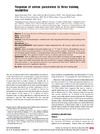Please use this identifier to cite or link to this item:
https://accedacris.ulpgc.es/jspui/handle/10553/76413
| Title: | Response of semen parameters to three training modalities | Authors: | Vaamonde, Diana Edir Da Silva-Grigoletto, Marzo García Manso, Juan Manuel Vaamonde-Lemos, Ricardo James Swanson, Robert Carlos Oehninger, Sergio |
UNESCO Clasification: | 241106 Fisiología del ejercicio | Keywords: | Sperm Morphology Reproductive Dysfunction Plasma-Concentrations Oxidative Stress Male Runners, et al |
Issue Date: | 2009 | Journal: | Fertility and sterility | Abstract: | Objective: To investigate the effect of different training modalities on various markers of semen quality.Design: Crossover study. Setting: Medical school.Patient(s): Forty-five men participated voluntarily in the study, being allocated into three groups according to their sports practice.Intervention(s): None.Main Outcome Measure(s): Sperm parameters (volume, liquefaction time, pH, viscosity, sperm count, motility, and morphology).Result(s): Sperm concentration; total sperin number; type "a," "b," and "d" velocity; and morphology were significantly different among the practitioners of the three different training modalities. Morphology was the parameter showing the greatest difference, even reaching clinical relevance for the triathlete group (4.7%, poor prognosis pattern). In addition, these parameters tended to decrease as training requirements increased.Conclusion(s): There are differences in the seminal profiles of individuals exercising in different modalities. The differences are more marked as intensity and volume of exercise increase, especially for morphology. These variables ought to be carefully analyzed and taken into account when designing a training protocol, especially with higher-level athletes, so that reproductive function is not compromised. (Fertil Steril (R) 2009;92:1941-6. (C)2009 by American Society for Reproductive Medicine.) | URI: | https://accedacris.ulpgc.es/handle/10553/76413 | ISSN: | 0015-0282 | DOI: | 10.1016/j.fertnstert.2008.09.010 | Source: | Fertility And Sterility[ISSN 0015-0282],v. 92 (6), p. 1941-1946, (Diciembre 2009) |
| Appears in Collections: | Artículos |
SCOPUSTM
Citations
87
checked on Jun 8, 2025
WEB OF SCIENCETM
Citations
67
checked on Jun 8, 2025
Page view(s)
160
checked on Dec 15, 2024
Download(s)
488
checked on Dec 15, 2024
Google ScholarTM
Check
Altmetric
Share
Export metadata
Items in accedaCRIS are protected by copyright, with all rights reserved, unless otherwise indicated.
